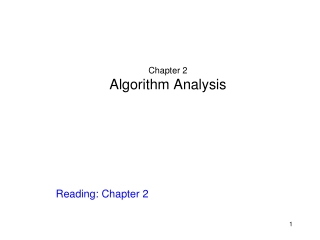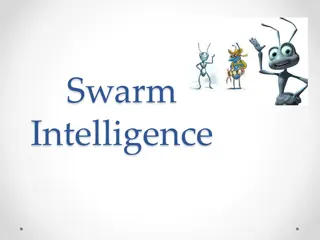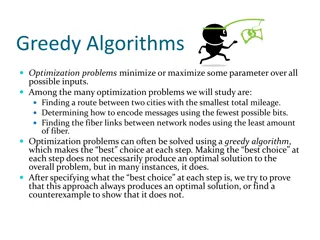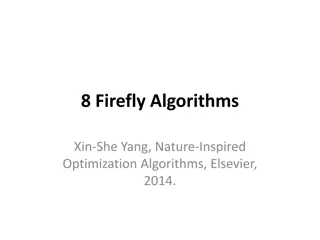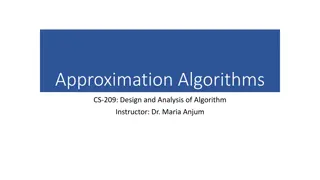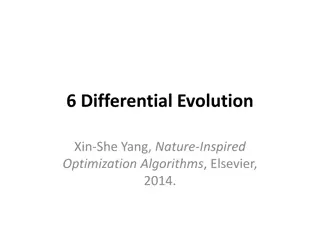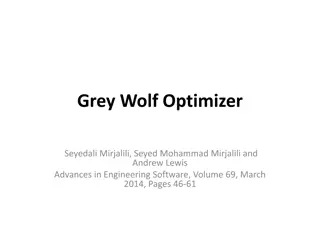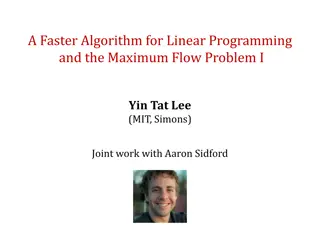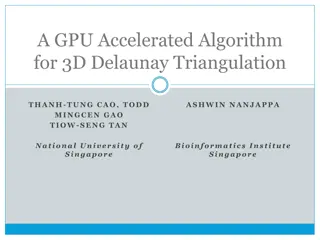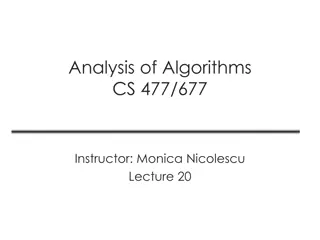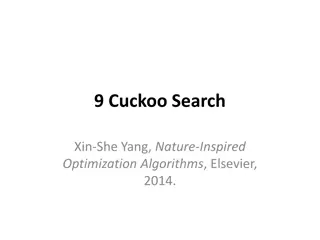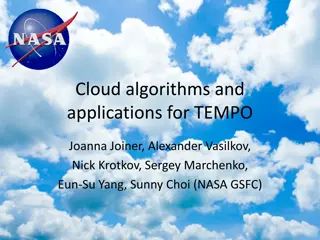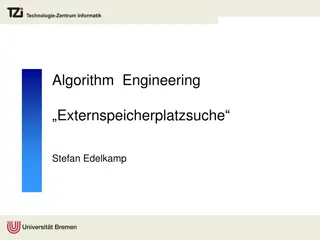Biologically Inspired Algorithms - Firefly Algorithm Overview
The Firefly Algorithm is a nature-inspired optimization technique based on the behavior of fireflies. It involves attraction between fireflies influenced by brightness and distance, with light intensity and absorption coefficient playing crucial roles in convergence. This algorithm determines new positions based on best evaluations and random movements, offering a unique approach to problem-solving.
Download Presentation

Please find below an Image/Link to download the presentation.
The content on the website is provided AS IS for your information and personal use only. It may not be sold, licensed, or shared on other websites without obtaining consent from the author.If you encounter any issues during the download, it is possible that the publisher has removed the file from their server.
You are allowed to download the files provided on this website for personal or commercial use, subject to the condition that they are used lawfully. All files are the property of their respective owners.
The content on the website is provided AS IS for your information and personal use only. It may not be sold, licensed, or shared on other websites without obtaining consent from the author.
E N D
Presentation Transcript
Biologically inspired algorithms Exercise 9 Ing. Lenka Skanderov , Ph. D. 19/02/25 1 text
Content Firefly algorithm text 19/02/25 2
History Swarm algorithm Developed in 2010 Some researchers point out the fact that it is too similar to PSO text 19/02/25 3
Firefly All fireflies are unisex one firefly is attracted by another firefly regardless of sex Attractivness of each firefly is based on its brightness the less brighter firefly will move towards the brighter one Attractivness is affected by the distance between fireflies. With increasing distance, it decreases If there is no brighter firefly in the vicinity of the actual firefly, the firefly will move randomly text 19/02/25 4
Light intensity ?(?)of a firefly ? = ?0? ?? Where ?0 original light intensity (usually corresponds to objective f. evaluation) ? light absorption coefficient ? distance between fireflies; distance between fireflies ? and ?: ???= ?? ?? 2 text 19/02/25 5
Light absorption coefficient ? Significantly influences the convergence of the algorithm Higher values close to : Attractivness will be almost 0 in the sight of other fireflies (foggy weather :0) ) random motion Smaller values close to 0: Attractivness is constant. Light intensity does not decrease. Firefly can be seen anywhere text 19/02/25 6
Attractivness of a firefly ? ? = ?0? ??2 ?0 attractivness for ? = 0, usually set to 1 ?0 In some publications, ? = (1+?) to avoid the absorption parameter tunning text 19/02/25 7
New position of firefly 2 ??= ??+ ?0? ???? ?? ?? + ??? ?? vector of random variables drawn from Gaussian distribution (0,1) ? 0,1 For the best firefly, there is no attractive firefly it will move randomly. The best firefly changes its position ONLY if the better position was found Other fireflies (no the best one) always change their positions regardless its evaluation text 19/02/25 8
Algorithm Initialize a population of fireflies ?? (? = 1,2, ,?) Set control parameters t=0 While t < MaxGeneration: for i in range(n) for j in range(n): Light intensity ?? at ?? is determined by ? ?? if ??> ??: Move firefly ? towards ? Attractiveness varies with distance ? via exp[ ??] Evaluate new solutions and update light intensity Rank the fireflies and find the current best firefly t += 1 text 19/02/25 9
Task Implement Firefly algorithm Parameter setting and recommendations: ?0= 1 I recommend to calculate with ? = Light Intensity ? is determined by the objective function evaluation Distance ??? between fireflies ? and ? is calculated based on Euclidean distance Set ? = 0.3, however, you can experiment with values from 0 to 1 Don t forget NORMAL DISTRIBUTION for calculation of ? Absorption coefficient ? affects algorithm convergence, try to set different values ?0 (1+?) instead of ? = ?0? ??2 to avoid the tunning of ? Visualize the process of search for the global optimum in 3-dimensional space. Use the test functions implemented for Task 1 19/02/25 10
Literature This presentation is based on the following publication: YANG, Xin-She. Firefly algorithm, stochastic test functions and design optimisation. International journal of bio-inspired computation, 2010, 2.2: 78-84. 19/02/25 11
Thank you for your attention Ing. Lenka Skanderov , Ph.D. EA 407 +420 597 325 967 lenka.skanderova@vsb.cz homel.vsb.cz/~ska206 text 19/02/25 12


